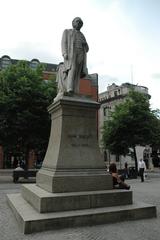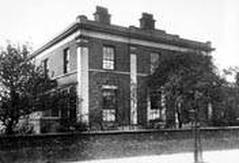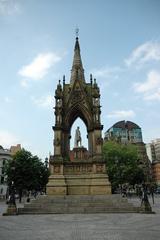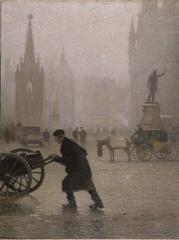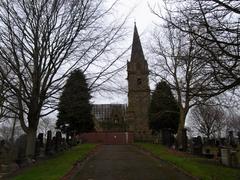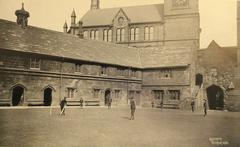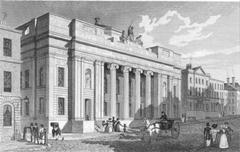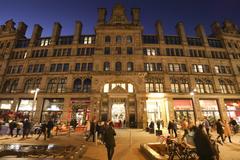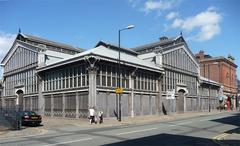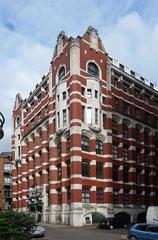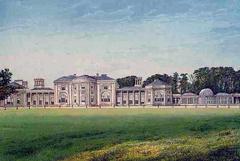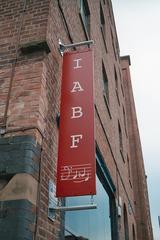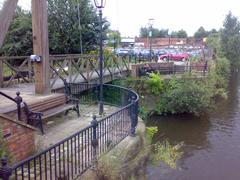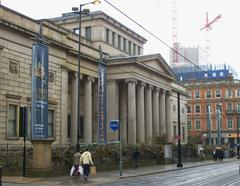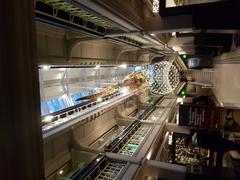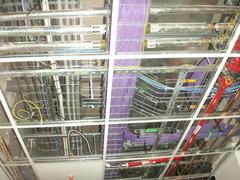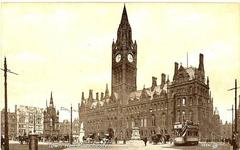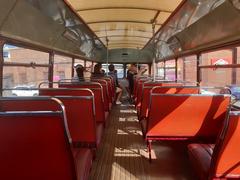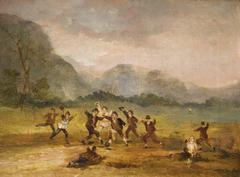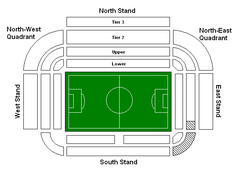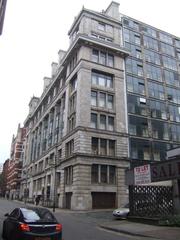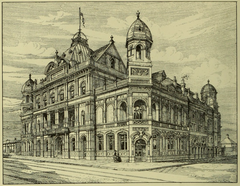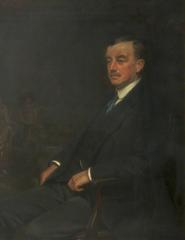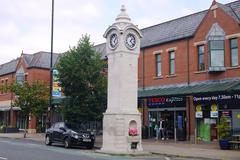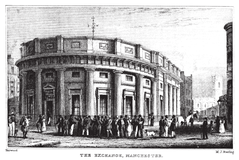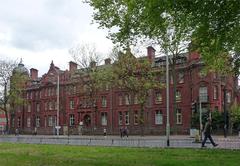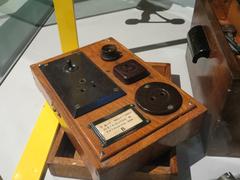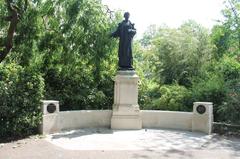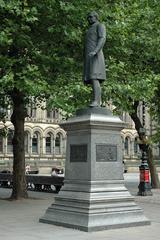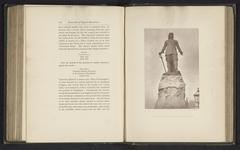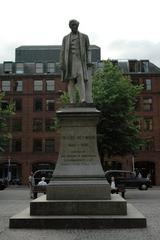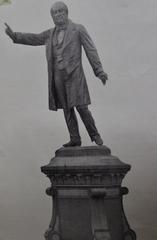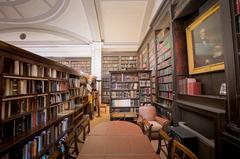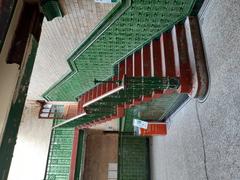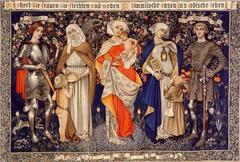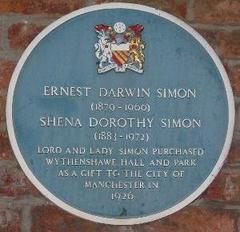
Statue of John Bright, Manchester: Visiting Hours, Tickets, and Historical Guide
Date: 14/06/2025
Introduction
The Statue of John Bright in Manchester stands as a lasting tribute to one of 19th-century Britain’s foremost reformers. Set in the heart of Albert Square, this monument celebrates Bright’s influential political career, social advocacy, and enduring impact on Manchester and the nation. Crafted by renowned Victorian sculptor Albert Bruce-Joy, the marble statue captures Bright’s dignified presence and oratorical prowess, reflecting both his Quaker roots and his public legacy. This guide provides comprehensive visitor information, historical context, practical tips, and insights into the statue’s artistic and cultural significance (Visit Manchester, Revealing Histories, Manchester Evening News).
Table of Contents
- Introduction
- Historical Background: John Bright and His Era
- The John Bright Statue in Manchester: Visitor Information
- Artistic Design and Symbolism
- Cultural and Historical Significance
- Preservation and Maintenance
- Visitor Experience and Practical Tips
- Frequently Asked Questions (FAQ)
- Summary and Recommendations
- References and Further Reading
Historical Background: John Bright and His Era
Early Life and Family
John Bright was born in Rochdale in 1811 into a prominent Quaker family deeply engaged in social reform. His father, Jacob Bright, owned a cotton mill and was active in local politics and philanthropy. The Quaker values of pacifism, integrity, and social justice shaped John’s worldview and later activism (Wikipedia). Bright received his education at Ackworth School, a Quaker institution, and was soon involved in local campaigns for religious and educational reform (Victorian Era). His siblings, including Jacob Bright, Priscilla Bright McLaren, and Margaret Bright Lucas, were also active in public life.
Industrial and Social Context
The early 19th century was a period of rapid industrial growth and social upheaval in Britain. Rochdale’s booming textile industry exemplified both economic progress and the stark inequalities of the era. Issues like high food prices, poor working conditions, and lack of political representation spurred widespread agitation for reform (Britannica).
The Anti-Corn Law League and Free Trade
Bright rose to national prominence as a leader of the Anti-Corn Law League, which campaigned for the repeal of tariffs on imported grain. These protectionist laws kept food prices high, disproportionately affecting the poor. Joining the League in 1839, Bright’s eloquence and moral clarity were instrumental in rallying public support. The successful repeal in 1846 marked a turning point in British economic policy (Wikipedia, Victorian Era).
Parliamentary Career and Reform
Elected as MP for Durham in 1843 and later representing Manchester and Birmingham, Bright championed parliamentary reform, religious liberty, and broader suffrage. He played a key role in the passage of the Second Reform Act of 1867, expanding the electorate and shaping the modern British political landscape. His oratory was legendary, and he was a leading figure in the Liberal Party (Britannica).
Pacifism and Internationalism
Guided by his Quaker faith, Bright was a consistent advocate of peace. He opposed the Crimean War, a stance that cost him his Manchester seat, but returned to Parliament to continue his advocacy. During the American Civil War, he supported the Union and abolition, despite its economic impact on Lancashire’s textile industry. His correspondence with Abraham Lincoln illustrates his international influence (About Manchester).
Later Life and Legacy
Bright held several government posts, including President of the Board of Trade and Chancellor of the Duchy of Lancaster (Victorian Era). He was twice married and fathered several children who continued the family’s public service tradition. Bright died in 1889, and his legacy is commemorated by statues in Manchester and Rochdale, as well as the naming of the town of Bright in Victoria, Australia (Historic England, Wikipedia).
The John Bright Statue in Manchester: Visitor Information
Location and Description
The statue stands in the southwest corner of Albert Square, directly facing Manchester Town Hall. Sculpted by Albert Bruce-Joy and unveiled in 1891, it depicts Bright in marble, standing in a dignified pose with one hand extended as if addressing an audience. The plinth bears his name and key dates, harmonizing with the surrounding Victorian architecture (Manchester Evening News, Revealing Histories).

Alt text: John Bright statue in Albert Square, Manchester, a marble statue of John Bright on a stone pedestal.
Visiting Hours and Admission
Albert Square is a public open space, accessible 24 hours a day, seven days a week. There is no admission fee or ticket required to visit the statue.
Accessibility
The square features step-free, paved walkways suitable for wheelchair users and those with mobility needs. Accessible public transport options, including Metrolink trams (St Peter’s Square stop) and bus routes, serve the area. Disabled parking is available in nearby car parks (Manchester City Council Parking). Assistance animals are welcome, and tactile paving and audible signals aid visually impaired visitors (AccessAble guide for Manchester).
Guided Tours and Events
The statue is featured in many walking tours exploring Manchester’s political and industrial history. Local guides and digital resources, such as the Manchester Pocket Guide, provide further context. Albert Square also hosts festivals, markets, and civic events throughout the year, during which the statue often serves as a focal point.
Nearby Attractions
Albert Square is surrounded by some of Manchester’s most notable sites:
- Manchester Town Hall: Neo-Gothic masterpiece (currently under restoration) (Manchester Town Hall)
- Manchester Art Gallery: Extensive art collections (Manchester Art Gallery)
- John Rylands Library: Victorian library with free admission (John Rylands Library)
- St Peter’s Square: Features Central Library and the Emmeline Pankhurst statue (Manchester Pocket Guide)
Artistic Design and Symbolism
Albert Bruce-Joy’s marble sculpture embodies Victorian ideals of dignity and public service. Bright is shown standing, one arm slightly extended, signifying his role as a persuasive public speaker and reformer. The statue’s simplicity honors his Quaker background—eschewing ostentation in favor of moral clarity (Revealing Histories).
The statue’s placement, facing the Town Hall and adjacent to monuments of other reformers, integrates it into Manchester’s broader narrative of civic progress and social change (I Love Manchester).
Cultural and Historical Significance
The John Bright statue is more than an artistic landmark; it is a testament to Manchester’s identity as a city of reform. Bright’s leadership in the Anti-Corn Law League and tireless advocacy for free trade, suffrage, and religious liberty are central to the city’s and country’s history. His role in the abolition movement and international affairs, particularly his support for the Union during the American Civil War, highlights Manchester’s global outlook (Manchester Evening News).
The monument’s unveiling was a major civic event, reflecting the esteem in which Bright was held. Today, it continues to inspire visitors and locals alike to reflect on the ongoing relevance of reform and justice.
Preservation and Maintenance
As a Grade II-listed monument, the statue is protected by UK heritage laws. Manchester City Council oversees its maintenance, including periodic cleaning and restoration. Information plaques and digital guides enhance the educational value for visitors (Revealing Histories).
Visitor Experience and Practical Tips
- Best Time to Visit: Early mornings or late afternoons offer optimal light for photography and a quieter atmosphere.
- Weather: Manchester weather can be unpredictable; bring appropriate clothing.
- Facilities: Public toilets are nearby at Central Library and Manchester Art Gallery. Many cafés and restaurants surround the square (Hard Rock Cafe).
- Safety: The area is generally safe, with regular patrols. Be mindful of personal belongings during large events.
- Photography: Photography is encouraged; tripods are allowed but should not obstruct pedestrian flow. Drone use may require council permission.
- Events: Check the Manchester Events Calendar for festivals or markets that may affect access.
Frequently Asked Questions (FAQ)
Q: Is there an admission fee for the Statue of John Bright?
A: No, the statue is in a public square and is free to visit at any time.
Q: What are the visiting hours?
A: Albert Square is open 24/7; the statue is always accessible.
Q: Are guided tours available?
A: Yes, many walking tours of Manchester include the statue. Check local providers for details.
Q: Is the site wheelchair accessible?
A: Yes, Albert Square offers step-free, paved access and nearby accessible facilities.
Q: Can I take photographs and use a tripod?
A: Yes, but please be considerate of other visitors.
Q: Is the statue part of Manchester’s listed heritage?
A: Yes, it is a Grade II-listed monument.
Summary and Recommendations
The Statue of John Bright offers a compelling encounter with Manchester’s heritage and the legacy of a reformer whose ideals still resonate. Its central location, year-round accessibility, and proximity to other landmarks make it a must-visit for anyone interested in history, politics, or Victorian art. Enhance your experience with guided tours or digital resources, and set aside time to explore the square’s vibrant surroundings and events.
For the latest visitor information, consult official resources or download the Audiala app for audio guides and interactive tours. Connect with the past—and with the spirit of reform that continues to shape Manchester today (Visit Manchester, Manchester City Council, Revealing Histories).
References and Further Reading
- Victorian Era: Biography of John Bright
- Britannica: John Bright
- Wikipedia: John Bright
- About Manchester: The Tale of the Statue That Came Home to Manchester
- Revealing Histories: Statue of John Bright
- Manchester Evening News: John Bright Statue in Manchester
- Manchester City Council: Town Hall Restoration
- Visit Manchester: Official Tourism Website
- I Love Manchester: Greater Manchester Sculptures & Statues
- Manchester Pocket Guide: Famous Landmarks
- Manchester Guided Tours
For further information, visitor support, and digital resources, consult the official websites linked above. Enhance your visit with the Audiala app and join us on social media for updates and tips.
